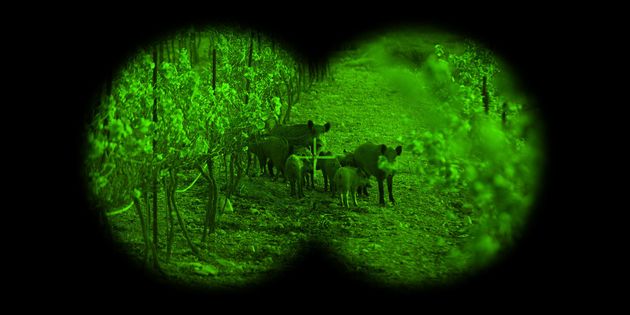We’ve all seen those military movies where the main characters engage in a night operation and don cool eyewear that gives them superhuman night-vision capabilities.
Almost every hunter instantly begins to drool, creating scenarios in their minds where those devices would help justify the expense when confronted by their significant other.
Here we’ll help solidify those potential arguments to win over your spouse and determine which Night Optical Device is best for your needs.

Photo credit: youtube.com
TL;DR: Night Vision vs Thermal
Night Vision Scopes | Thermal Scopes |
|---|---|
Pros | Pros |
|
|
Cons | Cons |
|
|
Best For | Best For |
Best for positively identifying a target before engagement | Great for locating a potential target in fog, foliage, or other environments that might offer concealment for a target |
What is Night Vision?
Night vision, or Night Vision Goggles (NVGs), are exactly what the names imply. These devices allow human beings to see in the dark. Because humans don't have a tapetum, like animals, to assist in seeing at night, we must rely on technology instead.
Night vision uses ambient light plus electricity to transmit starlight and moonlight, sometimes boosting an object's image 30,000 times or more than what can be seen by the naked eye.
How They Work
Night Vision Goggles take minimal available light and convert that into electricity. The NVGs then significantly increase the electricity before converting it back into the light to be viewed as an image.

Photo credit: wikipedia.org
The body of a pair of NVGs is a vacuum tube, known as an Image Intensifier Tube. In this tube, photons, or light particles, enter the objective lens, travel through the vacuum tube, and hit a photocathode that converts the photons into electrons.
The electrons pass through a microchannel and multiply by the thousands. After the electrons are multiplied, they travel through a phosphor screen, where they are converted back into photons to produce an image.
What is Thermal Vision?
Thermal Vision shows the heat, or thermal radiation, that an object emits. Every object, animate or inanimate, produces a thermal radiation signature. Thermal Vision detects that thermal radiation and translates it to the human eye in the form of colors.
Thermal Vision uses infrared light to detect the thermal signature that an object is emitting. It then displays hot and cold spots using colors.
How They Work
All thermal optics house microbolometers. Microbolometers are devices that measure infrared light in wavelengths. The microbolometers then use those wavelengths to assign a specific color. Lower temperature wavelengths are depicted in blues and purples, while warmer wavelengths are shown in yellows, oranges, and reds.
Some older versions of thermal optics depict thermal radiation in a white-hot or black-hot mode only. Meaning, any white are hot spots, or black can show as hot spots depending on the setting.
Relevant Characteristics Between Night Vision and Thermal
Use Case / Factor | Night Vision Scopes | Thermal Scopes |
|---|---|---|
Cost | Lower in cost due to being on the market longer | Higher in cost because more recently released for civilian use, and more internal parts |
Long Range | Shorter Range | Longer Range |
Foggy/Obstructed Use | Can’t see through fog or other concealments | Good view through fog or thick foliage |
Game Detection | Not great at game detection and works about the same as regular eyesight during the day | Great for game detection because it picks up heat signatures |
Game Identification | Great for game Identifying because it produces a clear image | Not as good at Identifying because images aren’t as sharp |
Equipment Durability | Pretty durable, scopes are good for mounting on rifles | Not as durable, better used in handheld mode |
Daytime Use | Not for Daytime Use | Can be used in Daytime |
Similarities and Differences
Let's take a look at some of the features these two types of night optical devices have in common and what separates them from each other. Both can fulfill specific needs while one or the other may be better for particular applications.
Night Vision and Thermal Differences
Cost
For most of us, the cost is the primary factor we consider when choosing between Night Vision and Thermal Vision. Even high-end Night Vision Goggles will be about the same price as low to middle range Thermals in this category.
The main reason for the disparity in cost is twofold. Night Vision has been available to civilians for a much longer period. So there are many companies producing night vision goggles. Also, Night Vision is a more straightforward construction and design.
In contrast, Thermal Imaging hasn't been available to civilians for as long, and only recently the military released the technology to the public. Because of this, the demand for Thermal Imaging is higher. Also, the internal construction of Thermal Devices is significantly more complex, which also adds to the cost.
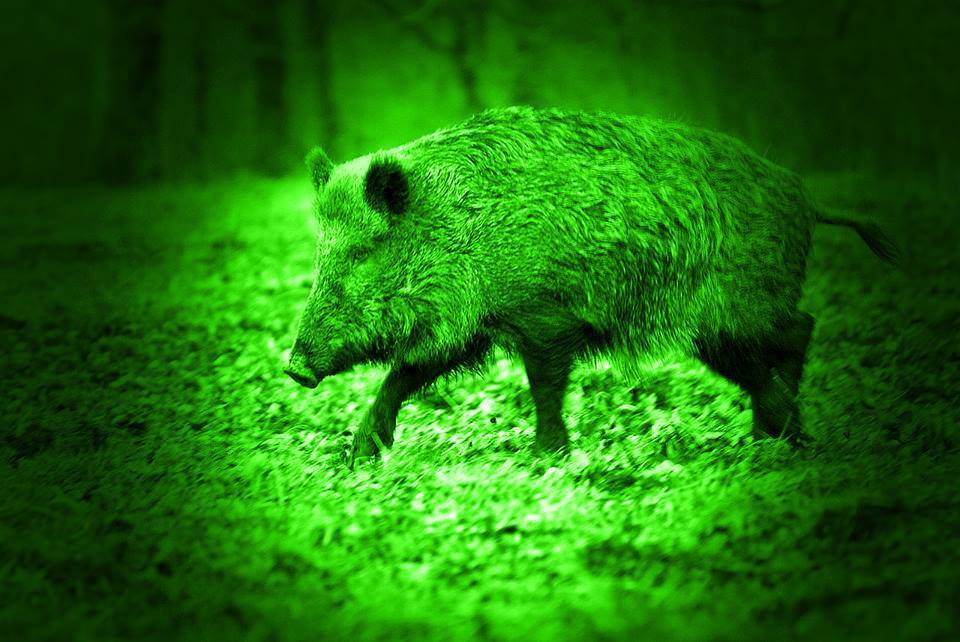
Photo credit: accufiretech.com
Range
The range is the second on the list of make-it or break-it details because these optics are primarily used for hunting. Because of the difference in designs, the optical range difference between these two Night Optic types can be significant.
Night Vision Goggles or scopes typically don't have much optical zoom capability because their internal components won't allow for it. So the range is often limited to the user's own eyesight. Some scopes might have a slight magnification.
Many soldiers will mount a flip-sight night optic in front of their rifle scope to compensate for the night vision optic's lack of magnification.
There is a second reason why NVGs aren't typically magnified. NVGs are generally designed to be worn over the eye or eyes while walking at night. If NVGs were magnified, this could cause many accidents while walking at night.
On the other hand, Thermals can have incredible zoom capabilities, allowing the user to zoom in on an object much like using a digital camera. Thermals can offer this capability because their internal construction is already so complex; adding this ability is a mere drop in the bucket compared to everything else going on inside.
Game Detection
Thermals win hands down at the game detection game. Thermals detect heat, so if you're peering out through some fog or light foliage, the warmth of an animal or a person will light up like Christmas.
Even though it won't give you a clear picture of who you're looking at, it will provide you with a general outline of the creature and offer up the animal's core for targeting.

Photo credit: thefirearmblog.com
Game Identification
Night Vision wins in the game identifying aspect. Because Night Vision works precisely the same way the human eye does--just enhanced for night purpose--it provides a clear picture of your target. If you're using Night Optics for home defense or hunting amongst livestock such as goats or domestic pigs, then night vision will be what you want.
In the military, they refer to this as the Positive Identification of a target. It's also why the military only uses Night Vision while clearing rooms. In a home defense or urban warfare environment, there isn't any margin for error.
Equipment Durability
The Night Vision optics will be more durable than most Thermal optics because the internal components aren't as fragile.
There are some relatively durable Thermal optics out there, like FLIR used by the military and Law Enforcement, but you're going to pay big for them.
Daytime Use
Most Night Vision Goggles or scopes can't be used in the daytime without damaging the device. It can harm the eyes of the user as well. It's kind of like looking at the sun; it won't take you long to figure out that it hurts.
However, some Thermals can be operated during the day because they use heat signatures instead of multiplying the light photons.
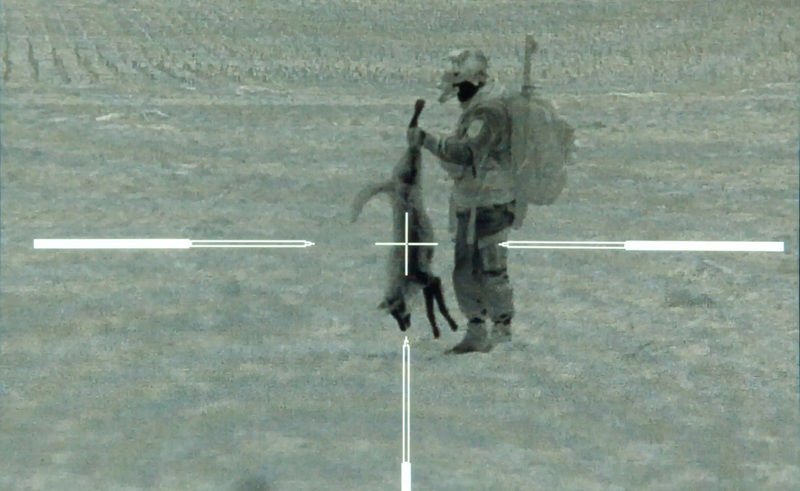
Photo credit: aberdeennews.com
Night Vision and Thermal Similarities
The similarities between Night Vision and Thermals are relatively sparse. They both fall under the umbrella of Night Optical Devices, but that's about it.
The United States Military combines the two categories to maximize their night operations. While in an over-watch position, soldiers will have a Thermal Optic customarily mounted on a tripod in what’s called a hide.
Using Thermal, soldiers will scan a sector looking for any heat signatures that stand out. Once a heat signature is identified with thermal, they’ll use their weapon with an infrared (IR) laser to highlight the target. Highlighting the target this way allows others in the squad to pinpoint the mark with their night vision.
Once the other unit members identify the highlighted target with night vision, they will confirm the target as human or animal. If human, they'll give further information such as hostile or merely a local out for a stroll.
Using this example, a person can see how these two optic types are best used in concert. A person can buy a cheap Thermal device to locate a potential target, then switch to a Night Vision Device to confirm what’s giving off the heat signature.
Advantages of Night Vision
Night Vision Devices offer the user the ability to see almost as clearly at night as one could during the day. In some cases, like in military use, soldiers train wearing Night Vision Goggles while walking in dark forests at night.
This training teaches the brain to compensate for the device, making them extremely lethal while navigating the night. Many infantrymen comment that they're so good with night vision that the Boogie Man comes to them for tips and tricks.
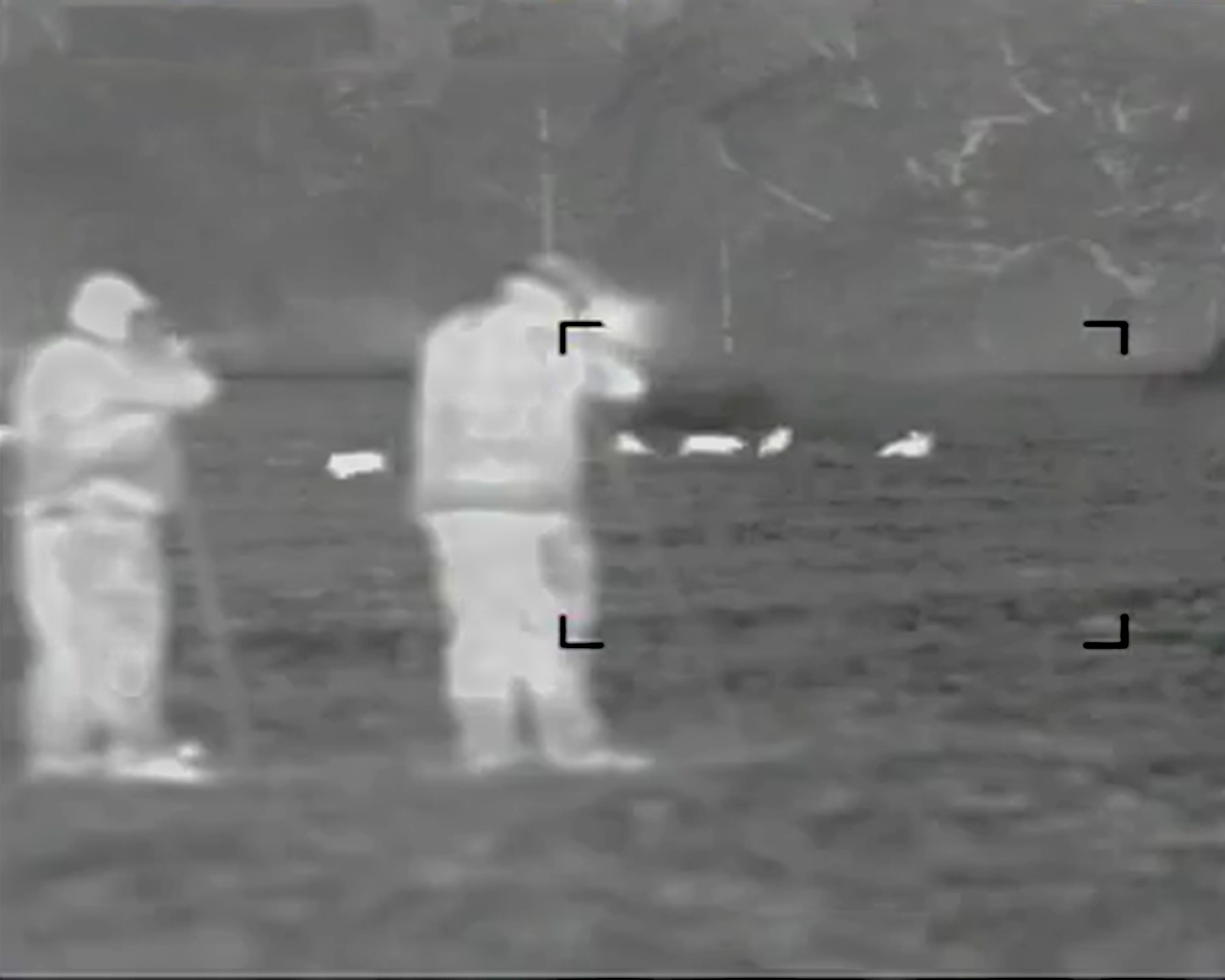
Photo credit: jagerpro.com
Night Vision offers a person the ability to clearly see their surroundings and positively identify any potential targets, without question. If operating in an environment where there are zero margins for error in target discernment, Night Vision is your choice.
Thermals are great for locating a potential target and can give you a general outline of the figure in front of you. If you're hunting hog in a field where there isn't anything else around, that might be fine. But, if you're trying to keep feral hogs from mingling with your domestic livestock, telling the difference between them is paramount.
This scenario is where Night Vision is king. Most thermals can't offer the clarity needed to determine the difference between a feral hog from a blue ribbon swine. Or the neighbors lost German Shepherd from that coyote that's been eating your chickens.
Summary
If you want to be sure that what you're about to shoot is the thing you intended to kill when you set out on the hunt, then Night Vision is the best choice for the job. If night hunting is a common activity, it's recommended to attach and zero an IR laser to your weapon. Doing this will not only let you know where your round will make contact with the target, But it will also allow anyone who's with you to see what you're about to shoot.
Advantages of Thermal Vision
Thermal Vision offers an entirely different ability for night hunting. It allows you to see the heat radiating from an object. If you've ever seen the movie "Predator," you understand this is incredibly awesome. More than simply a cool feature, though, it does offer some practical reasons for use.
Suppose you live in an area that’s prone to foggy nights or has dense foliage. In that case, thermals can burn through, revealing the radiant heat of a creature lurking in the bushes or fog. On frigid nights, if you're on a fresh trail, you can even track the difference in temperature left by a creature's feet.

Photo credit: flir.com
Because of the ability to light up a target's heat signature, Thermal Imaging makes a potential target jump out of an open field like a fireball. Anyone who has ever hunted during the early twilight hours knows that the human eye will play tricks on the mind in these periods.
Night Vision can help to mitigate this unless there is some concealment. In which case, Thermals will reveal any life hiding in the bushes. Thermal Optics are also available with some impressive zoom capabilities. If you see a hot spot in the middle of a 40-acre oat patch, you can zoom in and see the outline of that hot spot.
This zooming ability will help you determine whether the image you see is the wild hog you've been chasing or a freshly born calf that wasn't supposed to drop till next week. In which case, it's time to call off the hunt and get to work.
Summary
There are some instances where having a Thermal Optic is just all-around better. Sure they might not offer the clarity an NVG would. Still, they'll help locate a potential target and give a good outline of a creature to determine if it's the thing you're searching for. So if target discrimination isn't something you have to worry about, then a Thermal Optic might be all you need.
What About Infrared?
Infrared is light that’s emitted at a wavelength not visible by the naked eye. However, infrared, or IR, is light that is generally emitted by a source. Often when individuals are considering IR, they're referencing IR emitters of some kind.
IR emitters aid passive night optic devices, such as night vision, by providing light to dark interior rooms or thick forests that don't allow enough ambient light to multiply the electrons.
IR emitters are like flashlights that concentrate infrared energy on the target. The IR energy isn't detectable to the human eye. Many Night Vision Optics have built-in IR emitters that are good for up to about 30 yards.

Photo credit: amazon.co.uk
They help passive Gen 1 scopes in providing a brighter image. Some high-tech Gen 3 scopes do need help with an IR illuminator for the situations mentioned above. Medium to long-range emitters might also provide ranges of up to 500 yards.
While Gen 1 optics with IR emitters have one built-in, they're always on, and you're unable to shut them off. Gen 2 and up optics that have an emitter should come with an on/off switch.
The United States military uses IR emitters in IR flashlights that attach to their M4 carbines for stock.
Most people refer to these as Tactical Lights or Tac-Lights. The purpose of these IR emitters becomes apparent when you think of their use in these terms. A soldier or fire team of soldiers enters a room in the dead of night. The infantry typically operates at night when after High-Value Targets, or HVTs.
The HVT is almost always in a central space, away from any windows.
Because of this, as the soldiers progress further into the building's interior, the ambient light begins to decrease dramatically. It's at these moments the Team Leader will switch on his IR Tac-LIght.
Generally, only the Team Leader's Tac-light is needed, but that's left to the unit's Standard Operating Procedures or SOPs. With the IR emitter on, only the other soldiers equipped with Night Vision can see the light that’s produced.
The emitter allows them to proceed in the dark using the black void of the night as concealment. When the soldiers enter an interior room, the Tac-Lights help identify Enemy Combatants with weapons from non-combatants who don’t pose a threat. The ones without weapons get to live.
Once all enemies are suppressed, the Tac-Light is again used to determine if any individuals are the HVT. As you can see, an IR Tac-Light is an excellent addition to have if you're planning to hunt a target in a, particularly dark environment.
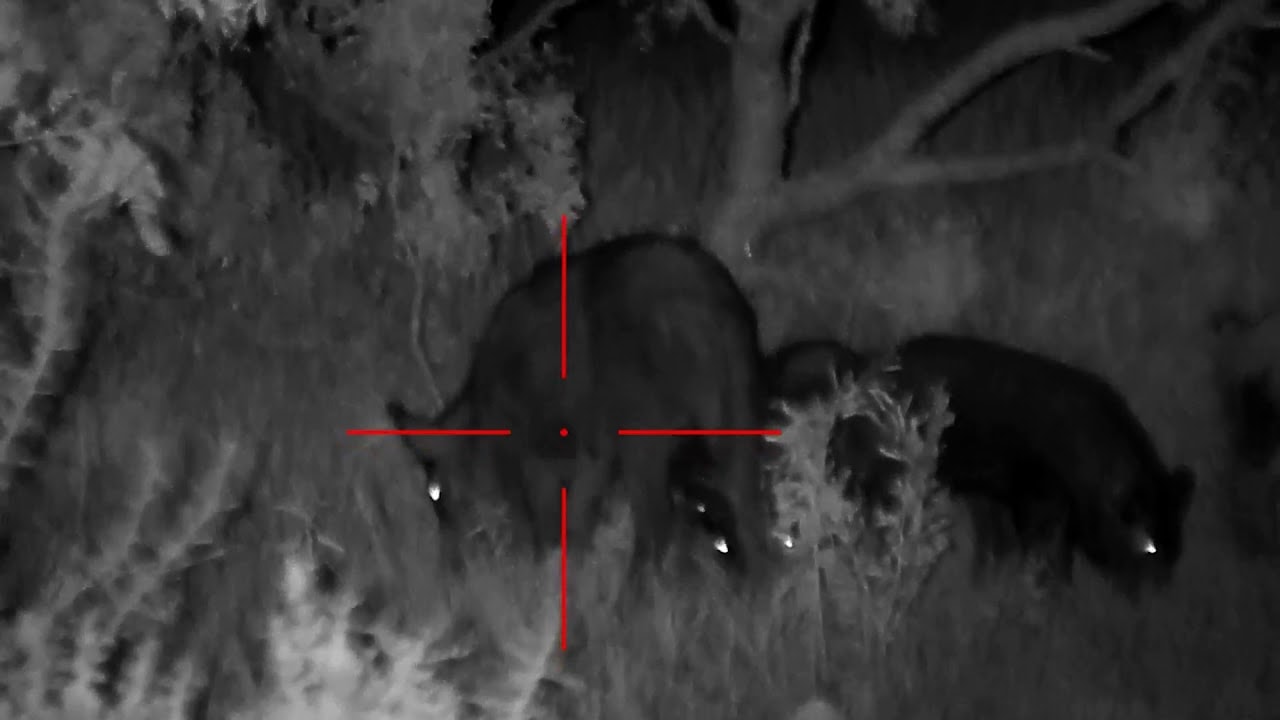
Photo credit: youtube.com
Bottom Line
As this article shows, when it comes to Night Vision or Thermals, they're two different aspects of Night Optical Devices that offer distinct advantages when conducting night operations.
Thermal Vision is excellent for detecting a potential target, while Night Vision is best for Positive Identification of that target. When trying to decide which you would prefer, it's always best to look at what the professionals use. In this case, the professionals are the military.
The military primarily relies on standard Night Vision Goggles while traversing terrain at night and employs Thermals when conducting overwatch operations. However, Special Forces have begun using devices that allow the wearer to toggle between Thermal and Night Vision. However, before you look for these devices, be prepared to give your first born as compensation.
People Also Ask
Here we have taken the questions most people ask and answer them preemptively. Everyone has differing needs when looking into what type of Night Optical Device to purchase, so we hope the questions and answers below help narrow down your search efforts.
Can You See Through Fog/Smoke With Night Vision?
Because Night Vision works the same as your regular Vision does, just enhanced, the same limitations apply. So, unfortunately, no, with Night Vision, you can't see through fog or smoke.
Can I Use a Night Vision Scope During The Day?
Night vision should be exclusively for nighttime use. However, there may be some situations where you require Positive Identification of your target despite lighting conditions.
Most night vision devices are only compatible with night use as daytime conditions can be destructive to internal components, but that's not written in stone. Some high-end Night Vision Optics can function in the daytime.
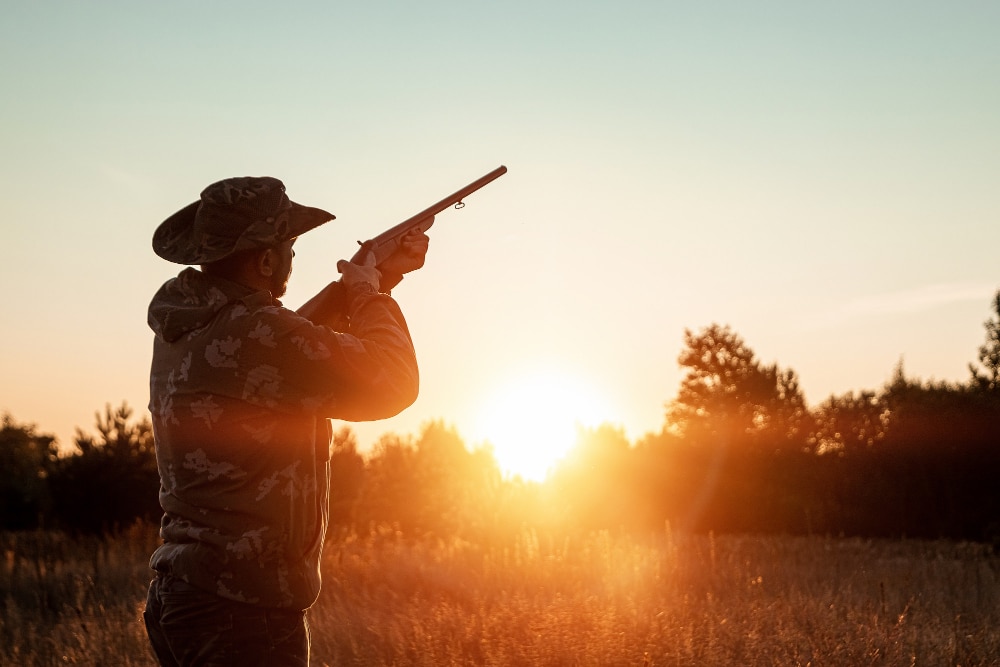
Does Night Vision Work In Total Darkness?
Unfortunately, if you find yourself in dark interiors without any ambient light, then no, Night Vision won't work. But It should be understood that Night Vision requires very little light to be functional. Even on a moonless night with cloud cover, there is still enough ambient light to allow Night Vision to operate.
Can A Thermal Scope See Through Walls?
No, Thermal Vision can't see through walls. Walls are normally thick and insulated enough to block any infrared radiation from the other side. When pointing a thermal camera at a wall, it detects heat from the wall.
However, there was a story from an infantryman who stated that when conducting overwatch operations before a hostage rescue mission that they could determine which room the hostages were being kept in, because of the temperature change on the wall's exterior surface.
It turns out the hostages were being held in that room, up against the wall, and their body heat was enough of variance that the Thermal Imager could detect the difference.


